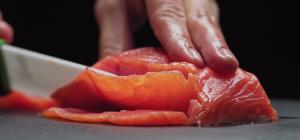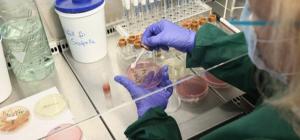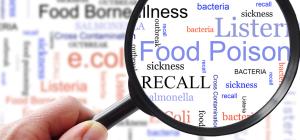
Microplastics in the mix: considering dietary sources and human exposure

Plastics provide many essential functions across society, being inexpensive, lightweight, and versatile in applications ranging from food packaging, to consumer products, textiles, vehicles, health care devices, personal protective equipment, and much more. In recent years, plastic pollution has gained an elevated public profile as a serious environmental issue, prompting calls for urgent action to address the environment impacts. However, knowledge gaps exist on the effect of plastic pollution on human health. This blog explores one of the pathways of exposure - ingestion of microplastics via food and drink.
What are microplastics?
Microplastics (MP) are typically defined as plastic particles that are ≤ 5 mm in size. They can be intentionally produced for use in manufacturing (primary MP), or formed from the breakdown of larger plastic articles (secondary MP). Secondary MP can be generated from the wear and tear of tires, coatings, artificial surfaces, the breakdown of plastic waste, the shedding of fibres from clothing and textiles, or released from cosmetics or personal care products. Particles less than 100 nm are referred to as nanoplastics. The shape of MP varies from thin fibres, to fragments, pellets, or films, of a range of polymer types, which can affect their dispersal in the environment or the body.
Where are MP in the environment?
MP are now ubiquitous in the environment, from the Galapagos Islands to the Canadian Arctic, having been detected in soil, water, air, and wildlife. Soils are the largest sink for MP, with the single largest input being from roads (wear from tires and road markings). Other sources include waste disposal, and land application of wastewater sludge. Waterways are the second largest sink, with direct inputs from wastewater, marine litter, and runoff from roads and land. The air is also a significant reservoir of MP, with roads also being the largest contributor. Both ocean and air currents transport MP around the world. (See: Draft science assessment of plastic pollution for more information on sources, fate, and occurrence of plastics in the environment)
Pathways of MP contamination of food and drink
With large reservoirs of MP in soils, oceans, and air, there are many pathways by which food can be contaminated with plastics. These include:
- Direct uptake by food animals from environmental sources
- Deposition on food surfaces, including food crops
- Environmental contamination of raw ingredients such as water or salt
- Deposition on food processing equipment or surfaces
- Deposition of dust on food within retail or home settings
- Release from plastic food contact materials (packaging, utensils, surfaces), especially following heating or mechanical actions (e.g., cutting, shaking, or opening packages)
Contamination may thus occur at multiple points from food harvesting, manufacturing, packaging, to consumer food preparation or dining.
Detection of MP in food and drink
MP have been detected in a range of food and drink items, with most studies focusing on marine foods and drinking water. A recent United Nations Environment Programme (UNEP) report on global plastic pollution, and other reviews (e.g., Jin et al. 2021, ECCC/HC 2020), have summarized the levels of MP detected in various food and drink items including salt, sugar, shellfish, fish, honey, beer, tap water, and bottled water. A few studies have also reported low levels of MP in meat, dairy products, fruits and vegetables and other edible crops. There remain many knowledge gaps across a range of food and drink types and there are limitations in comparing MP levels across existing studies. Most notably, some studies only report total particles visible under an optical microscope, whereas others use scanning electron microscopy to detect much smaller particles, including nanoplastics.
The types of polymers detected in food and drink vary, and are usually a mixture (e.g., polyethylene terephthalate (PET), polypropylene, polyethylene, cellophane (CP), rayon, polyester, polystyrene, etc.) of various shapes and sizes. Characteristics of MP particles can provide information on their origin. A comparison of MP in salt found higher levels of MP in sea and lake salt than in rock salt, suggesting greater inputs from environmental sources than from manufacturing or packaging. PET, commonly used in plastic bottles, was most prevalent in sea salt, whereas CP was the most prevalent in lake and rock salt, suggesting that different MP are dominant in different environments.
Production processes can also be a source of contamination. A study of beers from different manufacturers using common source water had vastly different concentrations of MP, suggesting contamination occurring in the manufacturing plant. In a study of bottled drinking water, higher levels of MP were found in finished water packaged in plastic bottles than in glass bottles at the same plant, indicating contamination arising directly from packaging. Food and drink studies also provide some information on commonly detected particle types, with fibres often being the most prevalent type in many marine foods (e.g., shellfish) and fragments and granules being prevalent in sea and lake salt. Different polymers detected in some shellfish indicate that where they are grown in the water column can influence the most prevalent MP detected, due to some MP floating near the surface, while others sink.
Estimating cumulative exposure to MP via food and drink
Although levels of MP in many food types are still unknown, some estimates of annual dietary intake have been calculated across typical food sources. Intake can vary based on the concentration found in local food sources, and by how much local consumers eat, as indicated by shellfish studies in Korea, Europe, and the UK. The UNEP report found differences in MP exposure for bottled water drinkers compared with those who only drink tap water (e.g., > 90,000 vs 4,000 particles per year respectively). Overall dietary exposure to MP has been estimated to be between 39,000 - 52,000 particles per year based on a US diet. This close to the estimated annual exposure from inhalation. One study estimated ingestion of MP from deposition of household dust on food could range from 13,731 - 68,415 particles per person per year. This suggests that exposure to ambient sources may be as important as food and drink sources. Studies of MP in human stool show that non-food sources can contribute significantly to total exposure. For example the levels and type of MP detected in stool of participants from a fishing community and a rural community in Indonesia did not correlate with levels detected in local food or water, suggesting exposure from other sources of (e.g., air, toothpaste, food packaging). It is estimated that more than 90% of particles ingested will be excreted, with only smaller particles (< 150 µm) able to crossing the lining of the gut. Knowledge gaps remain on the level of internal exposure to these small particles. (See: Institut national de la recherche scientifique (INRS) for further research on the health risks of exposure to nanoplastics).
Does exposure lead to human health effects?
Concerns about health effects from MP exposure are linked to possible physical impacts (ingesting small particles that could cause lesions or inflammation), chemical toxicity from mixtures of polymers and chemical additives or organic pollutants adsorbed to surfaces, or biological effects from pathogens or resistant bacteria attached to plastic surfaces. Most studies assessing the health effects have been animal-based, with some showing no effects, and others showing some impacts (e.g., ingestion of high concentrations of polyethylene caused changes to gut microbiota, inflammation, or immune response in mice).
A review by the Food and Agriculture Organization of the UN found that the risks to human health from exposure to MP in seafood are low, and a report by the World Health Organization states that there is no evidence of human health concern due to MP in drinking water. There are no epidemiological studies related to human ingestion of MP. A few studies detected MP in human colectomy samples, and human placenta, but no adverse health impacts were observed. Some in vitro toxicological studies on human cells show some effect on biological endpoints (e.g., cytotoxicity, immune response, oxidative stress), but responses vary by the MP shape, size and dose applied. There are some limitations in using existing studies to define overall health effects. Many do not use mixtures and concentrations of MP that would be typical of exposures in food. This makes health-based standards for MP in food or drink difficult to define, and none exists. The State of California is working towards the first health-based standards for MP in drinking water.
Summary
Current evidence shows that MP are everywhere, and dietary exposure is likely. While the public perception of human health risks from MP is high, there is currently a lack of evidence of human health effects resulting from ingestion of food and drink. Without significant global efforts, the quantity of MP in the environment is likely to increase in the coming decades, and it is logical to expect that exposure via all pathways, including food and drink, could increase over time. Given that exposure via non-food sources could be equally or more important, more human health effects studies will be needed in order to evaluate the importance of food versus non-food sources to the cumulative burden from MP.
Further characterization of the types of MP present across a range of dietary sources is needed to better quantify exposure. Further research on health effects of different polymers, shapes, sizes, and mixtures is also needed. Understanding sources of MP throughout the food production cycle could help identify whether interventions beyond reduction of plastic waste could reduce exposure at the food harvesting, manufacturing and processing stages (e.g., depuration of shellfish or additional treatment of source water to reduce MP).
(See Canada’s Plastic Science Agenda for information on addressing plastic waste and pollution in Canada)
Author
Juliette O'Keeffe is an EH and KT Scientist at NCCEH.








